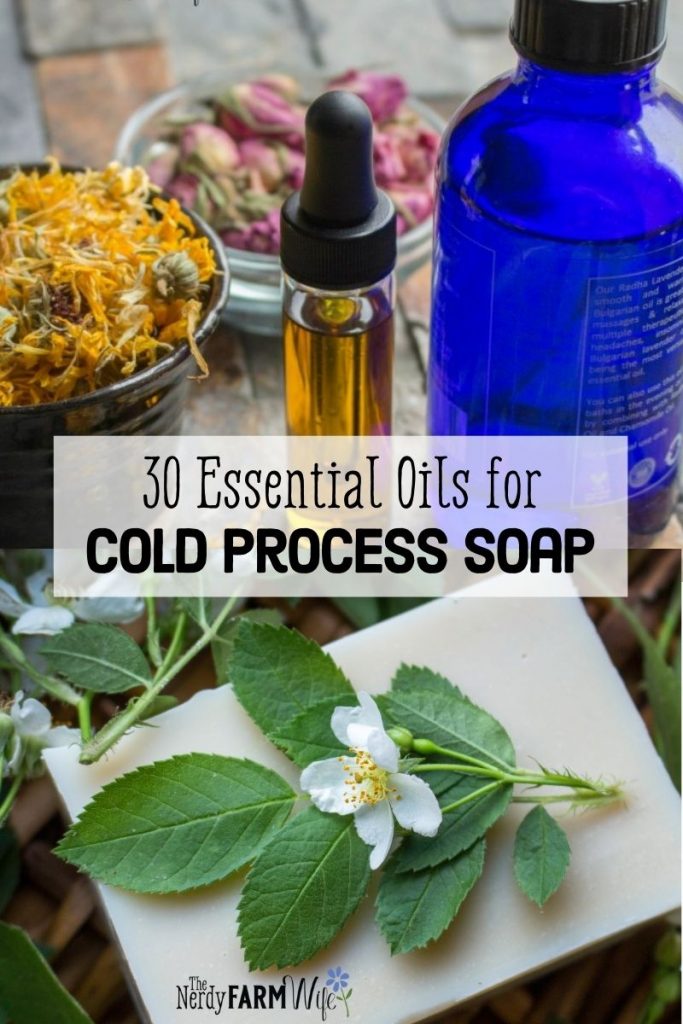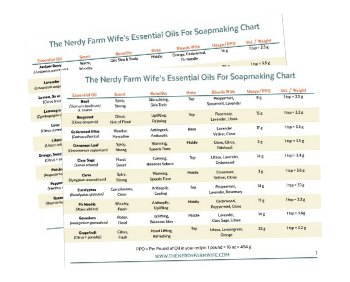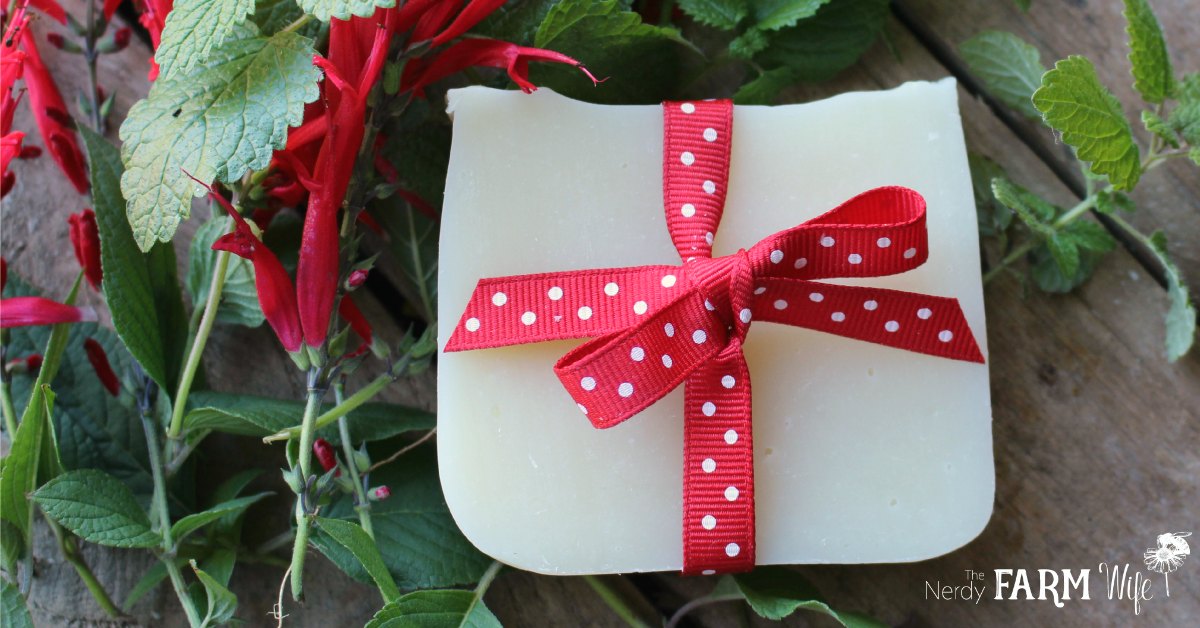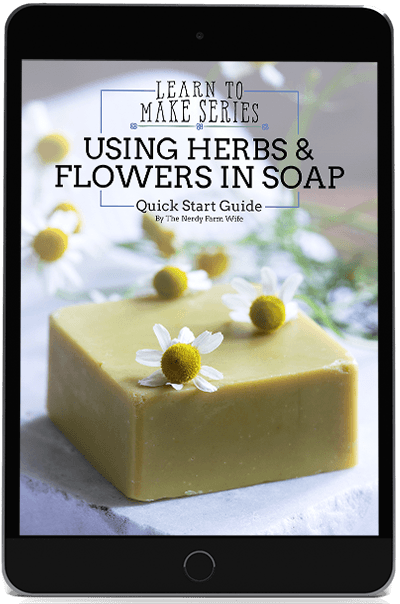30 Essential Oils for Soapmaking + Printable Chart (cold process)
Are you confused about which essential oils can be used when making cold process soap?
Wondering how much of an essential oil should you put in a batch of soap?
If so, this article and printable chart should help!

It can be downloaded and printed out, so you’ll always have it for easy reference when making soap.

The printable chart includes:
- Essential oil name
- Brief description of the essential oil
- A benefit or characteristic of the oil
- A few blend suggestions
- My preferred usage rate, per pound of oil – based on recommendations found in Essential Oil Safety by Robert Tisserand & Rodney Young, plus double checking with EO Calc, plus my personal experiences with the listed oils.
- Along with a rough volume/weight conversion if your scale doesn’t measure tiny amounts well
PPO = Per Pound of Oils in a recipe (1 pound = 16 oz = 454 g)
Essential Oils for Soapmaking Printable Chart
(See directions to download and print below.)
| Essential Oil | Scent | Benefits | Blends With | Rate (PPO) | Vol/Wt |
| Basil, Sweet (linalool CT) (Ocimum basilicum) | spicy, strong | stimulates, skin tonic | peppermint, spearmint, lavender | 7 g (1.5% max) | 1 tsp = 3.5 g |
| Bay Rum (West Indian) (Pimenta racemosa) | balsmanic | popular in men’s care | vetiver, clove, cinnamon | 4 g (0.9% max) | 1 tsp = 2.8 g |
| Bergamot (FCF) (Citrus bergamia) | citrus, floral | uplifts, relaxing | rosemary, lavender, litsea | 18 g (4%) | 1 tsp = 3.2 g |
| Cedarwood (Cedrus deodara) | woodsy, masculine | toning, antiseptic | lavender, clove, vetiver | 18 g (4%) | 1 tsp = 3.5 g |
| Cinnamon Leaf (Cinnamomum zeylanicum) | spicy, strong | warm, speeds trace | clove, citrus, patchouli | 2.7 g (0.6% max) | 1 tsp = 3.5 g |
| Clary Sage (Salvia sclarea) | earthy, floral | calming, balances skin | litsea, lavender, cedarwood | 13 g (3%) | 1 tsp = 3.4 g |
| Clove Leaf (Syzygium aromaticum) | spicy, strong | warm, speeds trace | cinnamon, vetiver, citrus | 2.7 g (0.6% max) | 1 tsp = 3.6 g |
| Coffee (Coffee arabica) | fresh coffee | aromatic, energizing | peppermint, clove, cinnamon | 13 g (3%) | 1 tsp = 3 g |
| Cypress (Cupressus sempervirens) | warm, woodsy | gentle, toning | fir needle, cedarwood, lavender | 18 g (4%) | 1 tsp = 3.2 g |
| Eucalyptus (Eucalyptus globulus) | clean, camphor | cooling, antiseptic | peppermint, lavender, rosemary | 13 g (3%) | 1 tsp = 3.1 g |
| Fir Needle (Abies sibirica) | woodsy, fresh | uplifts, antiseptic | cedarwood, peppermint, clove | 13 g (3%) | 1 tsp = 3.2 g |
| Geranium (Pelargonium graveolens) | rosy, floral | uplifts, balances skin | lavender, clary sage, litsea | 18 g (4%) | 1 tsp = 3.6 g |
| Grapefruit (Citrus × paradisi) | citrus, fresh | refreshing, uplifts mood | litsea, lemongrass, orange | 23 g (5%) | 1 tsp = 3.2 g |
| Juniper Berry (Juniperus communis) | warm, woodsy | for oily skin | orange, cedarwood, fir needle | 18 g (4%) | 1 tsp = 3.5 g |
| Lavender (Lavandula angustifolia) | floral, herbal | calming, antiseptic | litsea, cedarwood, geranium | 23 g (5%) | 1 tsp = 3.5 g |
| Lemon, Folded (5x, 10x) (Citrus limon) | citrus, fresh | cleansing, scent tends to fade | orange, rosemary, lime | 23 g (5%) | 1 tsp = 3 g |
| Lemongrass (Cymbopogon citratus) | lemony | anchors citrus | grapefruit, orange, lime | 18 g (4%) | 1 tsp = 3.1 g |
| Lime (Citrus aurantifolia) | citrus, fruity | astringent, cleansing | lemon, litsea, lemongrass | 23 g (5%) | 1 tsp = 3 g |
| Litsea (May Chang) (Litsea cubeba) | lemony | anchors citrus | lavender, orange, grapefruit | 18 g (4%) | 1 tsp = 3 g |
| Orange, Folded (5x or 10x) (Citrus × sinensis) | citrus, fruity | toning, joyful | grapefruit, litsea, lemon | 23 g (5%) | 1 tsp = 3.6 g |
| Palmarosa (Cymbopogon martinii) | earthy, rosy | skin benefits | lavender, litsea, bergamot | 13 g (3%) | 1 tsp = 3.3 g |
| Patchouli (Pogostemon cablin) | earthy, exotic | regenerate, anchors blends | cedarwood, lavender, orange | 18 g (4%) | 1 tsp = 3 g |
| Peppermint (Mentha × piperita) | minty, herbal | cooling, refreshing | lavender, rosemary, tea tree | 13 g (3%) | 1 tsp = 3.3 g |
| Peru Balsam (Myroxylon balsamum) | balsamic, vanilla | use small amounts | patchouli, lavender, orange | 4 g (0.9%) | 1 tsp = 2.9 g |
| Rosemary (Rosmarinus officinalis) | herbal, camphor | toning, hair growth | peppermint, lavender, bergamot | 13 g (3%) | 1 tsp = 3.4 g |
| Spearmint (Mentha spicata) | minty, sweet | gently cooling | peppermint, rosemary, lavender | 13 g (3%) | 1 tsp = 3.3 g |
| Spruce, Black (Picea mariana) | warm, woodsy | refreshing, uplifting | cedarwood, fir, peppermint | 18 g (4%) | 1 tsp = 3.2 g |
| Tea Tree (Melaleuca alternifolia) | resinous, antiseptic | antifungal | lavender, peppermint, clary sage | 13 g (3%) | 1 tsp = 3 g |
| Vetiver (Vetiveria zizanoides) | earthy, rich | restful, calming | lavender, cedarwood, clove | 7 g (1.5%) | 1 tsp = 2.9 g |
| Ylang Ylang (Cananga odorata) | floral, sensual | tranquil, skin tonic | geranium, lavender, citrus | 9 g (2%) | 1 tsp = 3.2 g |
FAQS about adding essential oil to soap:
Do I need to change the amount of oils or lye if I add an essential oil to a soap recipe?
No, you sure don’t! Essential oils are extras, just like oatmeal, honey, and natural colorants. They won’t change the amount of oils or lye used in your recipe.
When do I add essential oils to soap?
Add them just at emulsion, or when the soap reaches a very light trace.
How do I calculate more than one essential oil in a blend?
Figure the full amount of each essential oil, then multiply to get the percentage of each.
Example blend for a batch of soap with 32 oz (2 lbs) oil:
40% lavender
40% cedarwood
20% fir needle
First, figure out the lavender for the entire batch. (23 g x 2 lb = 46 g)
Next, figure out 40% of that number: (46 x 0.4 = 18.4 g)
For the cedarwood used at 18 grams per pound of oil, you will take 18 x 2 = 36 grams.
Next, figure out 40% of that number: (36 x 0.4 = 14.4 g)
Finally, the fir needle is used at 13 g PPO; take 13 x 2 = 26 grams.
Next, figure out 20% of that number: (26 x 0.2 = 5.2 g)
Your final blend for a batch of soap with 2 pounds of oil is:
18.4 grams lavender (40%)
14.4 grams cedarwood (40%)
5.2 grams fir needle (20%)
Do I calculate essential oils using the total weight of the soap batch, or just the oil amount?
Only calculate essential oil amounts based on the weight of the oils in your recipe. We don’t include water because it can vary widely in a recipe and much of it will eventually evaporate out during cure time.
How can I measure such small amounts of essential oils accurately?
I highly recommend a jeweler’s scale. I have a little Jennings Scale that works perfectly for weighing essential oils.
Math makes my brain hurt, is there an easier way to do this?
Yes! You can also run your blend through EO Calculator.
Some essential oils I don’t use in soap:
- Sandalwood – this is a threatened, endangered species and should be saved for special leave-on products such as salves and lotions
- Lemon Verbena – high rate of skin sensitization, so most soapermakers use a fragrance oil instead
- Sage – lots of warnings and contraindications, handle with care
- Wintergreen – many health contraindications, handle with care
To Grab Your Own Copy of the Printable Chart:
Click HERE or on the button below.
It will take you directly to a PDF file.
You can save this file to your computer and/or print it out for personal use.
If your browser won’t open PDF files, please send a message through my contact form and we’ll be happy to help! ?

This chart comes straight out of my Handmade Natural Soaps Ebook Collection which also includes:
- Handmade Natural Soaps Ebook
- Natural Facial Soaps Ebook
- All-Natural Milk Soaps Ebook
- DIY Specialty Soaps Ebook
- Guide to Using Essential Oils in Soap Ebook
- Troubleshooting Soap Guide
- Soapmaking Checklist to Keep You Organized
- and more!



Thanks for the chart. I am looking forward to using it! I finally made a batch of Goat Milk soap using your recipe and cannot wait for it to cure so I can try it. I also used your idea of dandelion tea with a batch of my favorite bar.
I had a couple of questions though, I hope you don’t mind. I have not seen a recipe of yours that uses lard, is this just personal preference? Also, I was wondering about the cooking oils by Lorann. It says it is peppermint oil, but I was wondering if it would work for soap?(I’ve got some leftover from holiday baking and was wondering if it would work)Thanks so much.
Hi HappyHomemaker! So glad that you like the chart! I don’t use lard or tallow a lot, but we do raise pastured pigs from time to time & I use the lard from those in soap sometimes. I guess I just naturally prefer working with butters, but lard & tallow are great substitutes for palm oil too & make for great soap! My new print book will have several recipes with lard or tallow in them, with vegetable butter alternatives for those who prefer to stay vegan. :)
As far as the cooking oils by Lorann – are they the food grade essential oils? If so, and that’s all they contain – just the pure essential oil, it’s possible they might work in soap. (Haven’t tried them to be sure though!) Baking extracts & flavorings (like vanilla or coconut) in general usually have added ingredients that can make your soap act strangely and those scents just don’t stay around in soap.
From what I understand, they are pure oil. They are the ones that are used to make hard candy ect… I know for sure they are not extracts. I may have to make a small batch and just give it a try and see what happens :)
Thanks for the comment on lard. My favorite soap has lard and I love the creaminess, but I haven’t been doing this for long, so I didn’t know if lard bars might go bad early or there was something about lard I didn’t know.
Thanks for your help!
Sounds great! I’d love to know how they work if you test them out! :)
Thank you so much for this chart. I was using fragrance oils for my soap making, but really wanted to start using essential oils. This chart makes it so much easier. :) Happy Homemaking
Hi Lisa, I’m so glad you found the chart helpful!
Happy soapmaking! :)
My question here is… When you want to use a mix of two our three esential oils by lb of soap you put the quanties of each one by separatly or the total you divide by two ir three… I Hope you understand my question….Thank you
Hi Beatriz, That’s a great question!
Yes, dividing by the amount of oils used is exactly what I do when I want to add more than one oil.
For example, if I want to add lavender and litsea to a soap with 1 pound of oils, I could take 20 g of lavender divided by 2, to get 10 grams of lavender,
then 17 grams of litsea divided by 2, to get roughly 8 or 9 grams of litsea.
That would total:
10 g lavender
8 (or 9) g litsea
in a recipe with 1 pound of oils.
You can also tweak the ratios around a bit.
For example if I wanted a much stronger lavender than litsea scent, I might use 2/3 the amount of lavender and 1/3 the amount of litsea, which would be:
about 13 g lavender
and about 5 g litsea
for every 1 pound of oils in the recipe.
The numbers are just a rough guideline that I use to make sure I keep the amount of essential oils in a conservatively safe range. There is some flexibility with them though, so feel free to adjust a little to suit scent preferences too! :)
Jan, this chart is most helpful. Thank you for putting it all together and sharing it. This makes MY life easier. Have a blessed day!
Hi Mary, I’m so glad that the chart is helpful for you! :)
I’ve been enjoying all your natural non-red palm recipes. We live in a very harsh environment-but dandelions and sunflowers grow well. I’ve used your wonderful articles and recipes to teach a class at our church. My class decided to be adventuresome and add infused oils to their collections. Keep up the wonderful work! We love all the knowledge and wonderful articles.
Hi Tiffany, So glad to hear that you’re enjoying the recipes! It sounds like a fun class & that everyone had lots of fun! :)
Jan just wanted to let you and your readers know that I used annatto infused olive oil in your carrot and honey soap recipe (from your web site) and it turned out great. Red palm oil is difficult to find where I live and very expensive. I infused annatto seed & olive oil in the sun with 2 tbsp per 8 oz of oil for three days. Though the soap is still curing the soap it is a very nice carroty color. I am very happy with the results! I had a question though, I read on a website for another carrot soap that the beta carotene in carrots can turn very white skin slightly orange like tanning solution. Have you heard that? How about with the annatto or alkanet infusions? I don’t see that there is enough of a concentration in the soaps to do that but I just wondered if you had ever had that experience? By the way you are still my favorite go to for inspiration. Thanks so much!
Hi Lisa! Your carrot soap sounds wonderful! :) It would take a lot of annatto seed for the soap lather to be discolored & it *might* stain a washcloth if you use too much, but I haven’t heard of it discoloring skin. I haven’t heard of or experienced that with carrot soap either, so you should be good to go with your soap! :)
I love your essential oil chart! What I’m wondering is what grade of essential oils do you use in your soaps? I’ve used oils from Brambleberry that are cheaper and they require quite a bit. I am checking into using other brands(young living, doterra, etc) that are more pure but since they are more pure I would think the usage rate would be much less? Do you have any experience with this?
Hi Jenni! I use an assortment of essential oil brands – Bramble Berry, Bulk Apothecary, New Directions Aromatics, NOW Brand, and also some Young Living blends before. However, they all act the same in soap so have the same usage rates, not matter the brand. It’s better to save your more expensive bottles of essential oils for products that aren’t washed off your skin, such as lotions, salves and balms. :)
Thank you for this information, I am a beginner soap maker and this will come in very handy :)
Hi Mary! I’m glad the information is helpful! Happy soapmaking! :)
Thanks a lot for all the tips you have shared!
Hi Uma! I’m glad they’re helpful! :)
Again – a big job and a great job!!! I am just excited, pleased, that I found you, in love with your job… all the best wishes comes from me to you and family! Every time I make soap, I thank God for brought me here. You gave me the strenght to begin!
Thank you!
Thank you Krasimira! I appreciate your kindness & support! <3 :)
Hi, I really need some troubleshooting help with your 100% olive oil soap that I can’t find any answer too anywhere! Please help before I go crazy!!
Hi Sue! Have you checked out my giant troubleshooting article yet?
https://thenerdyfarmwife.com/troubleshooting-cold-process-soap-problems/
If you can’t find the answer there, let me know more about the problem you’re having & I’m happy to help! :)
If I make Melt & Pour soap, are the amounts the same?
Hi Jonna! Melt and pour soap doesn’t need as much essential oil as cold process soap.
(This is because essential oil has to encounter active lye and a long cure time in cold process soap – which can fade it to different extents, but melt and pour is ready to go once you add the essential oil.)
For melt and pour, essential oil amounts can range from 0.5% for light scent to 2.5% for strong scent.
EO Calc is a really great tool to help you figure out the perfect amount for your melt & pour projects!
https://www.eocalc.com/enter-your-own-blend/
I hope to one day create an easy reference chart for essential oil for melt and pour soap to put on my website too. (It’s on my to-do list!) ?
Hello Jan,
Thank you so much for the article. I have not make soap yet and a bit intimidated. (Your essential oil come to save me :).
Question: how do I know percentage of the blend? Say if I want to make “Spearmint” blend, the formula suggested blending of Peppermint, Rosemary, Lavender. So are these list alway be 40%, 40%, and 20% in order listed?
I am so grateful and thank you in advance.
Pom
Hi Pom! I’m so glad the article is helpful! :)
The blend ideas that you see beside each essential oil in the chart, are other essential oils that should smell good when combined with it.
For spearmint, it combines well with peppermint, or with rosemary, or with lavender in soap. It also mixes nicely with other scents, but I only had a little room to type in that box! :)
So you wouldn’t mix up peppermint, rosemary, and lavender, to get a spearmint scent.
But a combination of 50% peppermint and 50% spearmint (“double mint” soap) smells nice!
If you have a soap recipe that gives specific amounts of essential oils, but you’re not sure of the percentage, you can figure it this way:
Example blend:
1 gram peppermint
1 gram rosemary
2 grams lavender
That’s a total of 4 grams of essential oils.
So you would divide the amount of each essential oil into 4 to get the percentage.
1 gram peppermint divided by 4 = 0.25 —– which is 25%
1 gram rosemary divided by 4 = 0.25 —– or 25%
2 grams lavender divided by 4 = 0.50 —– or 50%
If the recipe doesn’t give a number, then you will have to do some guesswork. Your thought of 40%, 40%, 20% is a good starting place!
You can then take your blend idea to the EO Calc and see how much to use for your recipe:
https://www.eocalc.com/enter-your-own-blend/
I hope that helps and good luck making your first batch of soap!
Hello
Why isn’t Pine (scotch) on your list ?
Kim
Hi Kim! That’s not one I personally use a lot when making soap, so didn’t think to add it.
I really need to update and expand this list though – hopefully this fall! ?
I would use it at the same rate as fir needle.
You may search online for the brand of the essential oil you’re using, and you will come across an IFRA compliance statement document for that specific brand.
Jan, thank you for all the work you have done. I am new to soap making and your instructions are very thorough and clear.
Smart and Capable is the new nerdy! ?
Hi Anna, So happy to hear you’ve found the site helpful! :)